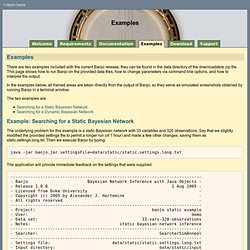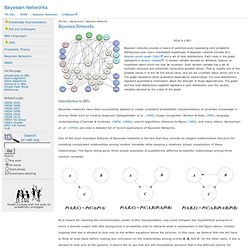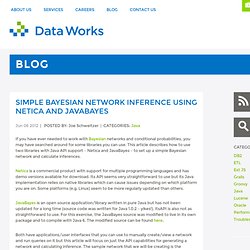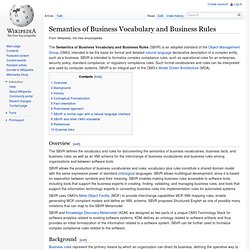

Réseaux bayésiens. Seor.gmu.edu/~klaskey/papers/Laskey_MEBN_Logic.pdf. R2RML and Direct Mapping Test Cases. This section presents the set of test cases we have created.

It is worth mentioning that the schema-qualified name feature is not excercise in the test cases. Each test case is described using the Test Metadata vocabulary in RDFa. Throughout all test cases, we use the base IRI < to turn relative IRIs generated by the Direct Mapping into absolute IRIs, as the required base IRI input to the R2RML processor. R2RML is a mapping language for SQL 2008. Title: one table, one column, zero rows. jBNC - Bayesian Network Classifier Toolbox. Netica Toolkits for Programming Bayesian Networks. The Netica APIs are a family of powerful Bayesian Network toolkits.

They allow you to build your own Bayesian belief networks and influence diagrams, do probabilistic inference, learn nets from data, modify nets, and save and restore nets. Each Netica API has the following features: World-renowned Engine. All Netica products are founded on the same core software engine. This engine has seen fourteen years of service, enhancement, and field testing, and is now a trusted component of many of the world's leading-edge Bayesian Network applications. If you are an experienced software developer, you will appreciate the following features: Speed.
If you are knowledgeable about Bayesian Networks, you will especially appreciate the following features: Learning. Versions of Netica API are available for most popular platforms, including Microsoft Windows 95/98/Me/NT4/2000/XP/Vista, Linux, Sun Sparc, Mac (68000, PPC: OS 6 to 9 & OS-X), Silicon Graphics and DOS. To email technical support, click here. Home. Banjo: Examples. There are two examples included with the current Banjo release; they can be found in the data directory of the downloadable zip file.

This page shows how to run Banjo on the provided data files, how to change parameters via command line options, and how to interpret the output. In the examples below, all framed areas are taken directly from the output of Banjo, so they serve as simulated screenshots obtained by running Banjo in a terminal window. The two examples are: Bayesian Networks. What is a BN?

Bayesian networks provide a means of parsimoniously expressing joint probability distributions over many interrelated hypotheses. A Bayesian network consists of a directed acyclic graph (DAG) and a set of local distributions. Each node in the graph represents a random variable. A random variable denotes an attribute, feature, or hypothesis about which we may be uncertain. Each random variable has a set of mutually exclusive and collectively exhaustive possible values.
Introduction to BNs Bayesian networks have been successfully applied to create consistent probabilistic representations of uncertain knowledge in diverse fields such as medical diagnosis (Spiegelhalter et al., 1989), image recognition (Booker & Hota, 1986), language understanding (Charniak & Goldman, 1989a, 1989b), search algorithms (Hansson & Mayer, 1989), and many others.
Pearl's Bi-directional Belief Updating Algorithm where the resulting column vector λ(B) is then transmitted to parent nodes. Footnotes. Which open source java library I can use to build a Bayesian network. Netica-J, for Programming Bayesian Networks in JAVA. Netica-J offers the complete Netica API in Java.

If you are a Java developer this is exactly what you have been wanting, a very clean and natural object-oriented way to access all of Netica's power. The Netica Java-API is one member of the family of Netica APIs, including ones for C, C++, and Visual Basic. This list outlines features specific to the Java-API. For the features shared by all the Netica APIs, please see the Netica API page. These sample programs show how easy it is to develop in Netica-J: Please see the parent page: Netica API Family regarding pricing. Each download archive is a complete ready-to-run kit that includes linkable libraries, documentation, and demonstration programs. The KnowhowCompany: Java Open Source Library for Bayesian Networks. JavaBayes - Bayesian Networks in Java. Simple Bayesian Network Inference Using Netica and JavaBayes - Blog - Data Works Inc.
If you have ever needed to work with Bayesian networks and conditional probabilities, you may have searched around for some libraries you can use.

This article describes how to use two libraries with Java API support – Netica and JavaBayes – to set up a simple Bayesian network and calculate inferences. Netica is a commercial product with support for multiple programming languages and has demo versions available for download. Its API seems very straightforward to use but its Java implementation relies on native libraries which can cause issues depending on which platform you are on. Some platforms (e.g. Linux) seem to be more regularly updated than others. Semantics of Business Vocabulary and Business Rules. The Semantics of Business Vocabulary and Business Rules (SBVR) is an adopted standard of the Object Management Group (OMG) intended to be the basis for formal and detailed natural language declarative description of a complex entity, such as a business.

SBVR is intended to formalize complex compliance rules, such as operational rules for an enterprise, security policy, standard compliance, or regulatory compliance rules. Such formal vocabularies and rules can be interpreted and used by computer systems. SBVR is an integral part of the OMG’s Model Driven Architecture (MDA). Overview[edit] The SBVR defines the vocabulary and rules for documenting the semantics of business vocabularies, business facts, and business rules; as well as an XMI schema for the interchange of business vocabularies and business rules among organizations and between software tools.
Background[edit] History[edit] Conceptual Formalization[edit] Linked Data.